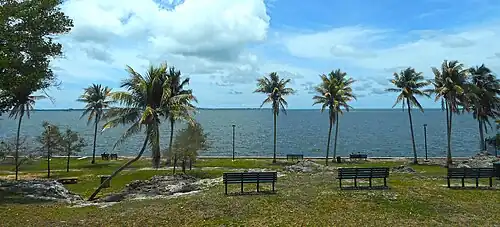Miami Rock Ridge

The Miami Rock Ridge is an oolitic, continuous outcrop of limestone, part of the Miami Formation, which formerly covered a large extent of southernmost South Florida; as part of an ecosystem it formed portions of the Everglades. Rising 7 to 8.6 m (23 to 28 ft) above sea level, it ranges from northern Miami-Dade County—the approximate latitude of North Miami Beach—southward to the upper Florida Keys and southwestward into Everglades National Park, creating a karst-dominated landscape.[1] The ridge is of Late Pleistocene origin. A series of tidal channels, dubbed transverse glades, formed within valleys in the ridge and acted as outlets for freshwater from the Everglades, thereby modifying the estuarine environment of Biscayne Bay.[2][a] One of the few areas above pre-drainage sea level, the Miami Rock Ridge was heavily exploited for agriculture and real estate.[5][6]
Ecology
The coastal ridge was traditionally a component of the endangered pine rocklands, which grew upon its length.[7] Globally imperiled today, the environmental community consisted of a large, unbroken expanse of South Florida slash pines (Pinus elliottii var. densa), interspersed by tropical hardwood hammocks; related to the Bahamian pineyards, it also occupied the Florida Keys.[8][7] The communities of the Miami Rock Ridge are sustained by wildfires, including those caused by lightning strikes, which affect the vegetation and its associates, maintaining biodiversity,[9][10] with a 20% floristic endemism rate.[7] Climate and an often-marly substrate limit the growth of vegetation, such that a mature subtropical hammock on the ridge typically is no taller than 59 feet (18 m).[11][12] Development has largely removed the original communities, which have fragmented into tiny parts of their original range;[7] remnants include Vizcaya Museum and Gardens, Simpson Park Hammock, and Alice Wainwright Park, which form part of Brickell Hammock, underlain by a large oolite outcrop, Silver Bluff.[13][14][b]
Gallery
-
 Miami Rock Ridge at Alice Wainwright Park
Miami Rock Ridge at Alice Wainwright Park -
 View of Biscayne Bay and Key Biscayne from atop the ridge
View of Biscayne Bay and Key Biscayne from atop the ridge -
 General view of ridge from below
General view of ridge from below
See also
- Arch Creek, Florida – Site of a natural arch in the Miami Rock Ridge
Notes
- ^ One of these glades enclosed the Miami River, a section of which sported a 6-foot-2+1⁄2-inch (1.892 m) waterfall and 450-foot-long (140 m) rapids until 1908, when it was progressively bypassed by the Miami Canal and partly dredged.[3][4]
- ^ Noted first by Bernard Romans in 1771, the bluff faced Biscayne Bay as a landmark; a freshwater spring, the Punch Bowl, once gushed nearby.[13][14]
References
- ^ Multiple sources:
- Meeder 2019
- "Pine Rocklands: A Disappearing Habitat". Miami-Dade Department of Environmental Resources Management. Miami-Dade County. Archived from the original on 15 May 2014. Retrieved 2019-06-11.
- Snyder, Herndon & Robertson Jr. 1990, pp. 234–5
- Trotta, Lauren. "Mountains of Miami". Biodiversity Institute. Gainesville, Florida: University of Florida. Retrieved 10 February 2024.
- Trotta et al. 2018
- ^ Meeder 2019.
- ^ Gaby 1993, p. 8.
- ^ Lodge 2010, pp. 175, 177–9.
- ^ Lodge 2010, pp. 174–80.
- ^ Snyder, Herndon & Robertson Jr. 1990, pp. 271–4.
- ^ a b c d "Pine Rocklands: A Disappearing Habitat". Miami-Dade Department of Environmental Resources Management. Miami-Dade County. Archived from the original on 15 May 2014. Retrieved 2019-06-11.
- ^ Sullivan, Janet (1994). "Kuchler Type: Subtropical Pine Forest". United States Forest Service. Archived from the original on 2010-01-26. Retrieved 2007-06-30.
- ^ U.S. Fish and Wildlife Service. "Florida Brickell-bush (Brickellia mosieri)" (PDF). Southeast Region. Archived from the original (PDF) on October 12, 2006. Retrieved 2007-06-30.
- ^ Miami-Dade County. "Pine Rocklands: Born From Fire" (PDF). Miami-Dade Department of Environmental Resources Management. Retrieved 2019-06-11.
- ^ University of Florida (1999). "Tropical Hardwood Hammock". South Florida Multi-species Recovery Plan (U.S. Fish and Wildlife Service). Retrieved 2007-06-30.
- ^ USFWS 1999, pp. 122, 124–7.
- ^ a b Gann, George; Seasholtz, Alex; Dutra, Elizabeth (2024). Ecological Restoration Plan for Historical Brickell Hammock Alice C. Wainwright Park, City of Miami, Florida (PDF). Institute for Regional Conservation (Report). Delray Beach, Florida. Retrieved 22 July 2025.
- ^ a b Parks 1980, pp. 41, 44.
Sources
- Gaby, Donald C. (1993). The Miami River and its Tributaries. Miami: The Historical Association of Southern Florida. ISBN 0-935761-04-7.
- Lodge, Thomas E. (2010). "Chapter 12: Peripheral Ecosystems of the Everglades". The Everglades Handbook: Understanding the Ecosystem (3rd ed.). Boca Raton, Florida: CRC Press. pp. 155–80. ISBN 978-1-4398-0262-5 – via Internet Archive.
- Meeder, John F. (24 July 2019). "Origin and development of true karst valleys in response to late Holocene sea-level change, the Transverse Glades of southeast Florida, USA". The Depositional Record. 5 (3). International Association of Sedimentologists: 558–577. doi:10.1002/dep2.84 – via Wiley.
- Parks, Arva Moore (1980) [1977]. The Forgotten Frontier: Florida Through the Lens of Ralph Middleton Munroe. Miami: Banyan Books. ISBN 0-916224-14-7.
- Snyder, James R.; Herndon, Alan; Robertson Jr., William B. (1990). "Chapter 8: South Florida Rockland". In Myers, Ronald L.; Ewel, John J. (eds.). Ecosystems of Florida. Orlando: University Press of Central Florida. pp. 230–77. ISBN 0-8130-1022-5 – via Internet Archive.
- "The Ecological Communities" (PDF). South Florida Multi-Species Recovery Plan (PDF) (Report). Atlanta: United States Fish and Wildlife Service Southeast Region. May 18, 1999. pp. 121–89.
- Trotta, Lauren B.; Baiser, Benjamin; Possley, Jennifer; Li, Daijang; Lange, James; Martin, Sarah; Sessa, Emily B. (9 October 2018). "Community phylogeny of the globally critically imperiled pine rockland ecosystem". American Journal of Botany. 105 (10). Botanical Society of America: 1735–1747. doi:10.1002/ajb2.1168 – via Wiley.